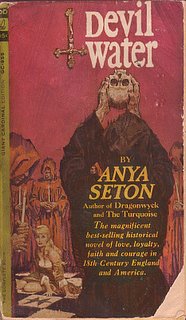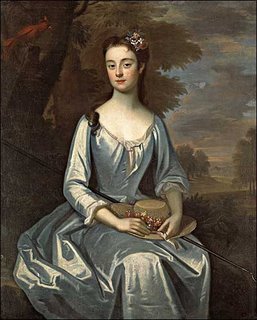I've rediscovered a favourite old book.
Like many historical fiction readers, Katherine by Anya Seton was an early and treasured experience of the genre. The leader of our youth theatre group suggested it to me and my best friend when we were in our impressionable early teen years. We loved it. That big fat novel offered real-life characters, a wealth of detail about the social and political and dynastic history of later 14th century. The protagonist was Geoffrey Chaucer's sister-in-law....Many years later, when I spent a very pleasant year (yes, an entire year!) in Chaucer studies during college, I was delighted to find Katherine on our syllabus. It was nice knowing that a "romance" book I loved so dearly was respected by my highly respectable and reputable professor.
I'm not exactly sure when I encountered Devil Water.

I suppose I found it on my grandmother's bookshelves. My copy, pictured above, has her address label pasted on the inside cover. She was interested in English aristocrats and the settlers of the Virginia Colony, having well-documented ancestral connections with both. She and my grandfather lived in Washington D.C. in 1963, when this edition was published. Perhaps she learned of the through one of her "First Family of Virginia"-type organisations. Or a friend recommended it because it was the book to be reading at the time.
In any case, it was old and yellowed when I first noticed it in her very large book collection. At that point, I'd only read Katherine, and Green Darkness. Spotting the Amazing Anya Seton's name on the spine, I asked to borrow the book. It turned out to be a very long loan...in fact, she must have said "Oh, you can keep it," because the paperback has remained in my possession down the decades, accompanying me from house to house.
Many, many years had passed since my last reading. Recently it occurred to me that though the action takes place about a decade after my work-in-progress concludes, it bears a few of similarities with my current project. The characters are real people but not household names (and Jenny Radcliffe, unlike her father and uncle, is positively obscure), they are mostly aristocrats, they lived in interesting times. I felt it was time for another glance.
The novel definitely held up after so long. I experienced it in a different way than ever before--I don't think I've read it since becoming published myself. I admire Seton's skill in depicting her characters, action, and especially setting. The people are generally flawed but are sympathetic without being too whitewashed, and thus believable. I prefer novels that contain many shades of grey, and get annoyed if there's too much black or white. The use of dialect would've bothered me if I hadn't already been so familiar with the book. In many a scene, especially those in Northumbria and on the Virginia plantations--it's laid on mighty thick and sometimes seems contrived. And unnecessary. A present-day editor would excise much of it, I daresay.
I have more quibbles with the Colonial Virginia portion of the story than any other, but nothing too grating. I've seen Westover Planation, and Berkeley, and Williamsburg, and Seton's research is impressive without (most of the time) being intrusive. That's true for the novel in its entirety.
That lurid cover on my 1963 edition is quite a joke, it represents a scene involving the Hell-fire Club which, though pivotal, is only described in narrative, after the fact.
My favourite character in the novel has to be the mysterious Evelyn Byrd, born on the James River and educated in England, where she fell in love. I knew her story from childhood (from my grandmother), even before I ever heard of Anya Seton.
This portrait of her is mentioned in the story, as is that red cardinal perched portentously in the tree on the left side.

Noodling around the Web, I found this interesting site belonging to somebody actually born at Dilston Hall, an important setting in the early part of the book. Warning--if you haven't read Devil Water, there are story spoilers. But if you know a lot about the Jacobite Rebellions--the Fifteen and the Forty-five--you might already know what happened to the Radcliffe brothers.
I definitely enjoyed reacquainting myself with the old friends--and enemies--between the covers of this book. The downside, of course, is that I'm sorely tempted to drag out my equally well-thumbed copies of Seton's Katherine and The Winthrop Woman. I could justify it as permissable "study" of the fictional historical biography genre...but on the other hand, I've got a book of my own to get into shape. So the continuance of my Seton glom must wait a few weeks, till I'm up at the cottage and in more of an editing than a composition frame of mind.
Everyone seems to know Katherine, and the fans of Green Darkness are legion. Seton's Arthurian series is fairly well known, I should think--or used to be.
Has anyone else out there read Devil Water? Any thoughts to share?

No comments:
Post a Comment